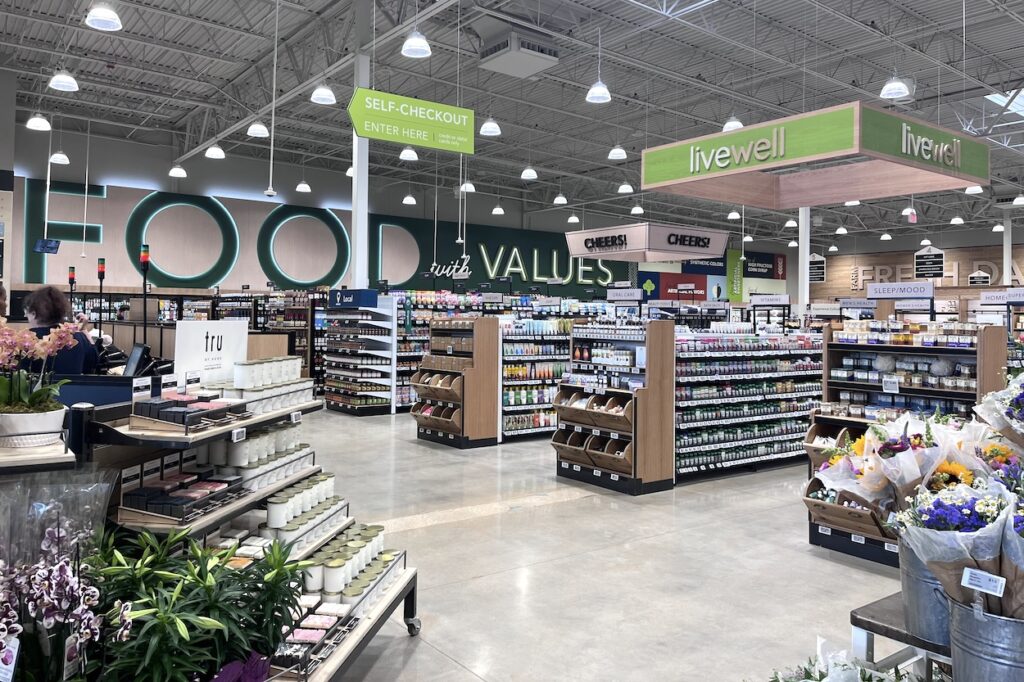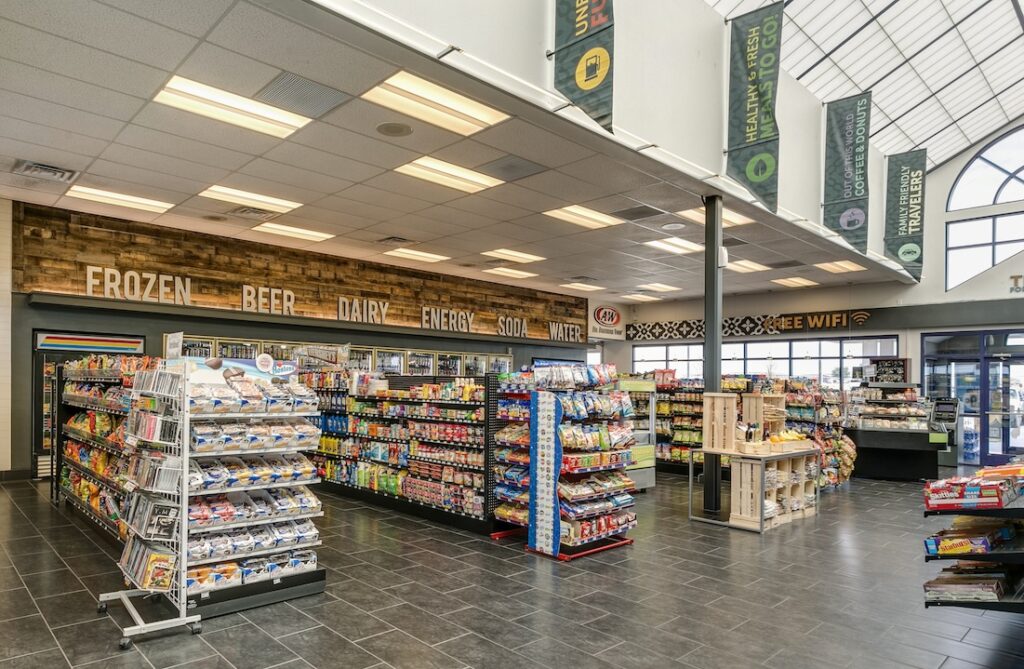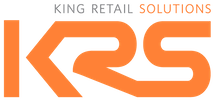Editor’s Note: This post was originally published in November 2021 and has since been expanded and revised for clarity.

Gondola shelving units
There are three basic types of gondola retail store shelving:
- Freestanding gondola units
- Wall-mounted fixtures
- Gondola endcaps
Gondola units are essential retail shelving options available in various heights, widths, and materials. However, not all gondolas are equal.
Taking their name from flat-bottomed boats, gondola units are designed with a base and a strong vertical spine. Thanks to this spine, they can support cantilevered shelves on both sides, which increases their ability to carry heavy items.
The vertical skeleton may be fabricated from steel, slatwall, pegboard, or solid board. Shelves, bins, racks, and other display fixtures are mounted to the spine. For maximum versatility, most gondola shelves are adjustable.
Gondola shelving may also be mobile through the use of casters or wheels. Most, however, are floor-mounted. The latter is ideally suited to displaying heavy merchandise such as wine, liquor, or canned goods. In most grocery stores, and some c-stores, gondolas have evolved from plain, functional, virtually invisible fixtures to design-forward store shelving solutions that showcase your store’s brand.
For a Whole Foods interior design, King Retail Solutions set apart shelves displaying coffee by creating a top fascia with the look of vintage barn wood and coordinating the color of vertical shelving supports to match. The broad top panel serves as a backdrop for bold signage, and the unit’s striking facade gives the feeling of a shop within a store.
Gondola units can also effectively carry aisle signs, a crucial element in both convenience stores and supermarkets. Signage systems are the perfect way to transform retail shelving from mere storage units to compelling storytelling devices. Chalkboard-style headers, and other signs used to highlight sales or seasonal offerings, can also be hung from a rail mounted atop the gondola.
[See Also: 6 Grocery Store Signage Trends]
When designing a gondola, store designers understand that one size doesn’t fit every merchandise category. Consumer shopping behavior varies with the type of merchandise being selected. If a shopper is replenishing grocery staples such as rice or flour, they’ll shop the shelves close to the floor without a second thought. However, the same shopper browsing for cosmetics is exploring, and they are less likely to “stoop” to do it. Instead, a wall unit in a cosmetic department can use that space for locking inventory storage cabinets for backstock.
"Understanding the psychology of shopping is key to designing effective retail shelving. Shoppers are willing to reach down for everyday items like rice or flour, but for cosmetics, they prefer products to be at eye level, where they can easily see and compare options. This allows for the lower shelves in cosmetic aisles to be cleverly used for additional storage, keeping the focus on the visually appealing displays above."
Sara Luker, Senior Designer at King Retail Solutions
Endcaps are just the beginning
Endcap shelving is a great way to highlight products close to the point of sale, offering an important opportunity to increase basket size. Endcaps make efficient use of space while also providing an unavoidable focal point for specialty merchandise, sale items, and high-margin-grab-and-go offerings. Endcaps offer the highest visibility in your retail store and are crucial to an impactful store design.
Convenience stores frequently use wire rack shelving as low-profile endcaps to ensure you don’t miss those impulsive sweet-and-salty purchases. But many convenience store fixtures are a jumble of different fixtures and finishes. While shoppers may not consciously register this problem, visually chaotic interiors inspire quicker exits. For a Jacksons c-store design, King Retail Solutions coordinated the color of wire racks and gondola shelving fixtures to give a seamless appearance that more effectively showcases merchandise. When trying to increase purchase size in the fast-paced c-store environment, lowering the visual “noise” sends subtle cues that help decelerate shoppers and invite increased purchases.
The design team at King Retail Solutions often “dresses up” endcaps by incorporating graphic signage into the header and using surrounds that call attention to a specific product. This makes an endcap more visible than plain shelving and maximizes this powerful display fixture.
Shelving materials
Good design also uses a mix of materials on gondolas in certain areas of the stores so that one continuous material isn’t used throughout. This allows a visual “break” between departments. For example, wood shelves are used in the bakery area to add warmth and a natural feel to the fixture, but an aisle holding canned foods may simply have painted metal shelves.
Retail display shelves are fabricated from a wide range of materials, including sheet metal, wire, wood, laminate over composite wood, glass, and, less commonly, plastic. Heavy-duty metal provides a space-saving low profile as well as strength and durability, but it can sometimes lack aesthetic appeal.
Because metal shelf finishes must be durable, powder-coating is the gold standard. However, depending on their use, shelves can also be painted. When buying “off the shelf” shelving fixtures, there’s typically a limited choice of colors with white, almond, and black as standard options. While shelves should never compete with merchandise for a shopper’s attention, having the ability to specify custom shelving colors can make a subtle yet profound difference in the look and feel of a grocery store interior.
Wood shelves and wood-look shelving create a richer, warmer, or higher-end appearance. Glass shelving, a standby of many boutiques and gift shops, is used sparingly in the c-store and grocery store environment, reserved for feature displays of higher-end merchandise, such as cosmetics.
Ready to elevate
your retail shelving?
Up against the wall: wall-mounted shelving
Typically used in areas where space is at a premium, wall-mounted shelves are not as deep as gondola shelving units. One favorite due to its versatility is slatwall (also known as slot wall). Originally patented in the mid-1960s, slatwall was a fresh approach to merchandising, incorporating various accessories, including bins, baskets, feature lights, and sign holders. Because of its affordability and ease of installation, slatwall become ubiquitous in the retail world. By the 1980s, slatwall’s standard white finish had become a dreary cliché and it fell out of favor.
However, as store designers look to midcentury materials for inspiration, slatwall has enjoyed a revival. Today, a more comprehensive array of finishes, including graphics, metal, and updated wood laminates, are applied to this space-saving classic. And there’s no need to stick with the default three-inch-on-center design of off-the-shelf slatwall panels: slatwall and its accessory shelves can be custom-fabricated to suit the size of the displayed merchandise.
Rack ‘em up
Lightweight, freestanding racks, typically constructed from metal or epoxy-coated wire, aren’t the core of most grocery store shelving but are still indispensable thanks to their ability to be quickly disassembled and moved. While they don’t offer the strength of gondola shelving, they are go-to fixtures in many grocery store bakery and gourmet departments or small stores where maximum flexibility is required. Though black and chrome finishes are typical, store designers can also specify custom colors to give wire rack shelving a branded, more upscale look.
Shelf conscious
Retail shelving units no longer just hold products; they’re a part of a store’s communication strategy. New forms of signage are increasingly leveraging precious real estate at or near eye level. This includes traditional shelf-talkers, new types of digital signage, and interactive signage that responds to the presence of a shopper’s smartphone. Exercise restraint, however: shelf signage should enhance awareness of the merchandise but never overwhelm it.
Store Layout

The positioning of your shelving units is as important as the fixtures themselves. Most grocery stores rely on a grid layout, which is highly efficient and offers straightforward navigation among merchandise categories.
Grid layouts, however, are generally not engaging. To elevate the shopping journey to one that feels experiential, designers can build in more variation in both the type of retail fixtures and their placement. In many supermarkets that once held long, unbroken aisles of the same shelves, store layouts now incorporate more aisle “blocks” to relieve monotony and aid shoppers in navigating the interior.
A fundamental requirement in designing a supermarket shelving layout is the necessity for two shopping carts to pass each other with a comfortable margin. In traditional convenience stores, where shopping carts are not usually a factor, the designer must instead consider what consumer behavior expert Paco Underhill famously dubbed the “butt brush factor.” This refers to the ability of a shopper to stand in front of shelves with enough room for another person to pass without brushing against their derriere.
[See Also: 7 Store Planning Strategies for a Customer-Centric Experience]
Shelving fixtures: custom vs. “off the shelf”
When designing a new grocery or c-store, or updating an existing one, sometimes your budget dictates purchasing shelving units off the shelf and focusing your design resources elsewhere. While these core fixtures provide an important storytelling “canvas” that shouldn’t be neglected, they can also be augmented with judicious use of custom fixtures as well.
At King Retail Solutions, our designers balance gondola and shelving units with custom merchandisers and fixtures that create a hierarchy of highlighted products. When custom fixtures aren’t a practical option, using material and color choices on shelving is still possible to help differentiate departments or product offerings.
Whether your store fixtures are completely custom-designed or a combination of custom and off-the-shelf units, establishing a unified, holistic interior design is critical in creating an appealing environment that provides the infrastructure for a great customer experience.
Summary
Importance of Retail Shelving
- Retail shelving units provide crucial infrastructure for creating an inviting experience for customers.
- They are often taken for granted but play a vital role in retail environments.
- These fixtures are the heart of convenience stores, grocery stores, and other retail outlets.
Customer Interaction
- Customers interact with store shelving dozens of times during an average visit.
- Shelving placement and type can greatly influence the shopping experience.
- The subconscious impact of shelving should not be underestimated.
Visual Merchandising
- Shelving is where visual merchandising meets the road.
- Properly designed shelving enhances product visibility and appeal.
- Strategic shelving placement influences customer perception and behavior.
Influence on Shopping Experience
- The types of shelving fixtures and their placement significantly affect the shopping experience.
- Thoughtful shelving placement can create a more inviting and efficient shopping environment.
- Shelving design and placement are crucial for maximizing customer interaction and satisfaction.
Considerations Before Purchase
- Thorough consideration of shelving design, fabrication, and purchase is necessary.
- Investing in quality shelving can yield long-term benefits in customer satisfaction and sales.
- Proper planning and design are essential before installing shelving units.
Maximizing Benefits
- Focus on strategic placement and thoughtful design to maximize the benefits of retail shelving.
- Shelving fixtures deserve careful consideration to enhance the overall shopping experience.
- Effective shelving solutions can lead to improved customer interaction and increased sales
Frequently Asked Questions
- What are the design considerations for convenience store shelving?
Design considerations for C-store shelving involves maximizing display space, optimizing product visibility, ensuring easy access for customers, and facilitating efficient restocking. These factors are crucial for creating an attractive and functional layout that enhances the shopping experience. - How does gondola grocery store shelving optimize space and customer flow?
Gondola grocery store shelving optimizes space utilization and customer flow by featuring adjustable shelves to accommodate various product sizes. Strategically placed throughout the store, these shelves create well-defined aisles, guiding customers seamlessly through different sections and encouraging impulse purchases. - What are the different types of retail shelving available for a modern store?
Various types of retail shelving cater to modern store needs. Gondola shelving offers versatility with adjustable shelves, while wall-mounted shelving maximizes vertical space. End cap displays and aisle shelving provide prime real estate for promotions, and specialty shelving systems allow for customizable displays to meet specific merchandising requirements. - How can store shelving be customized to enhance product visibility?
Customizing store shelving enhances product visibility through strategies like adjustable shelves, LED lighting, clear signage, and strategically placed mirrors. These elements attract attention, guide customer focus, and create an engaging shopping environment.
